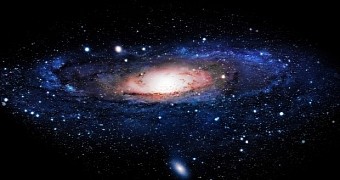There comes a time in every galaxy's life when its gas and dust reserves begin to dwindle and forming new stars becomes an impossible task. Astronomers describe such galaxies as being red and dead.
Dead because they no longer have enough gas and dust to birth new stars and red because, as they age and near their demise, the stars comprising them switch to being, well, red.
Interestingly, researchers with the Royal Astronomical Society now claim that it sometimes happens that such comatose galaxies are brought back to life and begin forming stars once more.
Reviving a red and dead galaxy
Just like individual stars, galaxies like to hang out in groups known to astronomers as clusters. Our home galaxy, the Milky Way, is too part of a cluster dubbed the Local Group.
Writing in the journal Monthly Notices of the Royal Astronomical Society, researchers explain that, every once in a while, galactic clusters get too close to one another and wound up merging.
When this happens, an insane amount of energy is released. As detailed by specialist Andra Stroe of Leiden Observatory and University of Lisbon scientist David Sobral, this energy moves through space as a cosmic tsunami of sorts.
The researchers go on to say that, having reached a galaxy or another, the shock wave transforms it. In the case of read and dead galaxies, it revives them in that it reignites star-forming processes.
“Much like a teaspoon stirring a mug of coffee, the shocks lead to turbulence in the galactic gas,” Leiden Observatory astronomer Andra Stroe explained the phenomenon in an interview.
Furthermore, “These then trigger an avalanche-like collapse, which eventually leads to the formation of very dense, cold gas clouds, which are vital for the formation of new stars.”
According to data delivered by ground-based telescopes on the island of La Palma in Spain and in Hawaii, several comatose galaxies are now being revived in this manner in a merging cluster located some 2.3 billion light-years away.
The galaxies' new life doesn't last long
Evidence indicates that the stars created during such times of turmoil only hang around for a few million years before exploding as supernovae and ripping their home galaxy apart.
What this means is that resurrected galaxies have an incredibly short second lifespan and go back to being comatose soon after having been resurrected by a galactic cluster merger.
In fact, researchers theorize that, in the aftermath of revival episode of this kind, galaxies end up even more dead and red that they were before their miraculous return to life.

 14 DAY TRIAL //
14 DAY TRIAL //